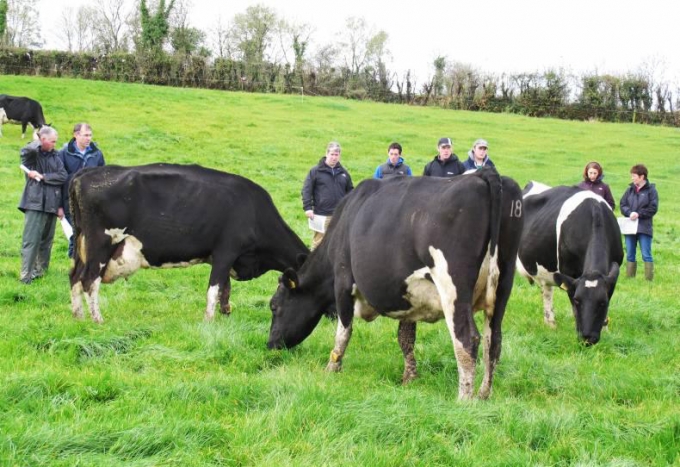Dairylink: Plans are put in place for 2016 following a review of 2015 financial performance
18th February 2016

Conail Keown assesses performance for Bill Brown, Co Down and Robin Clements, Co Tyrone discussing planned changes for 2016.
Given the extremely low output prices and relatively high cost of production preserving cash reserves has been the primary focus for Bill, forcing him to look at all aspects of the business for cost savings in 2016.
Capital expenditure of £5,000 incurred in 2015 on a building project plus a similar spend on purchased forage in July 2015 placed additional pressure on cash reserves coming into the winter of 2015.
Gross output for the farm came in at £366,146. This includes livestock sales from cull cows and calf sales.
Total cash costs for the farm came in at £310,053 for 2015. This did not include capital and interest repayments on loans or personal drawings. A breakdown of the main variable costs can be seen above.
Purchased concentrate for the dairy herd was the most significant cost on the farm, at £107,456. This included purchased minerals for both dairy cows and dry cows for the 12 months.
In 2016, the focus will be on replacing purchased concentrate with quality grass and silage. Improving milk solids and herd fertility are also targeted. However, results from both these will take up to five years to filter into improved herd performance.
Concentrate feeding is an obvious area for cost savings to be made, with just short of 500t of dairy cow concentrate purchased and brought onto the farm during 2015.
Feed efficiency within the main dairy herd can improve. Feed will be targeted at the right cows throughout 2016. A full rethink on heifer concentrate feeding is also ongoing. Both will bring immediate savings.
The budget is to reduce the feed bill from £107,456 to £95,328 without impacting milk output. Changes in replacement heifer feeding on the farm throughout 2016 will result in a cost saving of a further £5,122.
The farm budget for 2016 has a cash cost of production at 21.57 ppl. For Bill, this represents a £28,680 reduction in production cost compared to 2015 actual costs.
Most of this saving is a result of reducing the purchased feed coming onto the farm. Other cost savings will also happen. While individually these savings may be small, when added together planned savings for 2016 in veterinary and medicine, farm energy and other dairy costs, contracting charges, farm wages and drawings will make the difference for Billís bottom line.
Key Figures
Area farmed:
- Whole farm 105 ha
- Grazing area: 90 ha
- Milking cows: 185
- Litres sold 1.61 million
- Meal fed 2.67t/cow
- Gross output £366,146
- Fixed costs £70,379
- Variable costs: £234,500

Robin Clements: New farm purchase
The end of 2015 has seen significant structural change for Robin Clements and family, with the purchase of a new 64ha farm three miles from the home unit.
Setting up the dairy business to manage this new investment is now top priority for the Clements family.
During 2015, 30 additional cows were introduced to the herd, with 28 home reared heifers also brought into the herd, moving cow numbers to the current level of 145 and production just over one million litres at the end of February 2016.
Gross output for the farm came in at £238,971. This includes livestock sales from cull cows and calf sales.
Total cash costs for the farm came in at £199,540 for 2015. This does not include capital or interest repayments on loans or personal drawings.
A breakdown of the main variable costs can be seen in the graph above. Purchased concentrate for the dairy herd was the most significant variable cost on the farm, at £53,651. This includes minerals and vitamins.
To maximise return from the new land block, Robin needs to expand herd size and output. At current performance, herd size needs to be 220 cows producing just over 1.6 million litres each year in order to service investments.
Robin is aware herd performance and technical efficiency must also improve.
The challenge for the Clementsí business is to expand cow numbers with a limited grazing block of 45ha on the home farm, while maximising the new 64ha block three miles away.
In the short term, Robin intends to cut and bring home fresh grass from the new farm to plug the feed shortage.
With facilities for 220 cows already on the home farm, only funds for cow purchase are required.
Robin already uses a zero grazing machine on the farm, so no new investment is required in machinery. Higher running and replacement costs have been factored into future budgets for the farm.
This farm is very much a family-run operation with both sons, and Robinís wife Heather involved in the business.
The current contracting business will be down scaled to free up family labour with some casual labour introduced for peak periods at calving, breeding and silage-making seasons.
Key Figures
Area farmed:
- 45 ha grazing block
- 28 ha outfarm
- 64 ha (recently purchased
- Milking cows: 145
- Litres sold: 1m
- Meal fed 1.85t/cow
- Fixed costs: £93,620
- Variable costs: £134,106
- Gross output: £238,971

This article has been reproduced with the kind permission of the Irish Farmers Journal. Please click on the below Irish Farmers Journal logo to be brought to additional dairy articles
